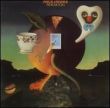Joined: 24 Sep 2008 United States  Karma Karma: 16 
|
yes, it would be a A minor add9. Starting on C would have no immediate consequence(it does depending on things just bare with me). To me it seems that question your asking is what chord/harmony are our ears going to hear even through the chord may be more then one thing.
we get four chords(more like broken chords at spots) when we make each voice(note) the root
A(1),C(3),E(5),B(9)=A minor add9
B(1),E(4),A(b7),C(b9)= B7 sus4 b9
C(1),E(3),B(7),A(13)= C major13(no 5th,9th) or C major7 add6 (no 5th)
E(1),A(4),B(5),C(b6)= E sus4 b6
chords are my thoughts on them defiantly aren't the only ones nor the best. The sus chords could easily be 11ths just seems better to me for a few reasons to be sus
so now about are ears/brains. Are brains tend to preconceive info at what ever info the senses takes in. Easy way to explain this is when with one eye open you see one color hue and the color eye another hue but when both open it gets fix, or when looking into a microscope with both eyes open you can make it so all you see is the miroc thingy, or try drawing something up side down you will draw better way your using your eyes not your brains preconceptions.
hearing works the same way. So we come into a musical bit with preconceive notion and we will fill in the blanks and a whole other bunch of stuff the brains good at. Now weather this is learned behavior of some universal thing is of no consequence for us it just happens and that what matters.
so when you first start out, the listener's brains are trying to find pattens, something recognizable, and in Homophony(The musical format all western countries peoples grew up with and quite possibly only thing they listen to beside Monophony(just one note at a time and that's all like singing by yourself) it's the most popular in world too just all of us are western beside like one or two and i don't think they come around anymore might be wrong) trying to find the key. It important you understand keys, the tonic center, here there not scales has more to do with chords then scales.
so seeing that A minor add9 is the most full chord people ears may tend to pull to that and try to make one of the minor scales the key. but that doesn't mean really anything because what is important here is how your voicing these notes. As i have said before melodic and harmonic principals are interwoven that can be study apart but need to be play with each other in mind even if your single note soloing.
so your question about starting with "C". your could very well be doing a inversion with c in the base. or make your go back to A people ears will first hear it as a 3rd. how to make it a 6th play the A higher or even a octave higher(kind of a jump though) to make it a 13th. What if you play a C then a E you just started play a major 3rd know people first thought is it's in the key of C.
but all of this is pointless if a key has already been established. it will become what ever chord it need to be at the moment it's play weather it good or not is the voicing. It's all about the voicing. I can play you a Minor 7 and then just revoice the chord and make it sound like a Major 6. Your can sub a minor 7 chord of the "ii" degree for a "IV" degree spot in a already established key and progress even with a minor 7 voicing and it will sound like major 6.
So in finale comments. What matters is; is the key and progress established, How am I voicing the run, What chord/harmony I'm i playing over, and how is that chord voiced.
@Sch_player I'm sorry I started writing got bored and came back, but yeah your saying everything right, at least in my mind. decide the root is other way of saying deciding the key for THIS instances
edit- also wanted to add. if you play a "C" then a "E" people's first thoughts are going to be a C major triad but your have to keep up that keys sound. because you can quickly change it. depending on the follow note. a C to end E doesn't Cement the key in, you could just be as easily ascending the scale in other key depending on the following notes/harmonies. |






